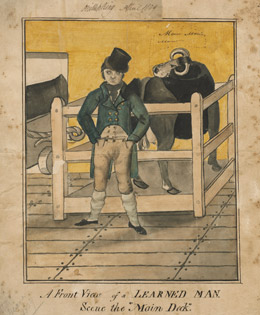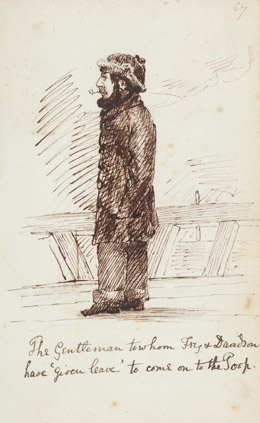Class distinctions
Passengers travelling on emigrant ships from the United Kingdom to Australia in the 1800s were physically segregated according to class, marital status, and gender. Cabin class passengers were usually accommodated below the poop deck with steerage passengers below the main deck. Steerage passengers were further separated into single men, married couples and children, while single women were strictly segregated from all other passengers.
Different levels of shipboard accommodation determined social class for the voyage, and dictated where migrants could move on board. Cabin class passengers (usually first and second class) had the poop deck at their disposal, while most passengers from steerage were confined to the main deck. How strictly these class boundaries were enforced depended not only on passenger personality but also on the ship’s Captain, the Surgeon-Superintendent and the Matron charged with the emigrants’ supervision.
Only one in ten emigrants could afford the price of a cabin. For the remaining passengers, both assisted and unassisted, home at sea was below the main deck in steerage quarters converted from cargo spaces. This area was dark, crowded and close to the water line – when seas were rough passengers were often shut in with poor ventilation.
'I trust something occurs that may vary the theme when we get a little further south by that time I may be able to learn a little more of my fellow passengers or prisoners which we may be called, for the Steerage of a ship like this looks very near it' - Steerage to Australia: a diary of John Sceales voyage on the "North Briton", 910.45/222
Steerage quarters had berths lining the walls and a long dining table in the middle. Passengers were organised into messes of eight to ten people prior to embarkation, and usually given berths close to friends or passengers from the same region. Emigrants cooked, ate, washed and cleaned within their mess and to a timetable specifying when each mess could do their chores.
The daily routine in steerage began at 6am with washing, dressing and tidying up before breakfast. Emigrants would then clear away and begin their chores: cleaning berths, scrubbing decks, and doing washing. Single men were expected to help out with extra tasks but steerage passengers with children could have very long days. Tea was about 5 pm, with lights out at 10 pm.
Between meals and chores, steerage passengers used their leisure time to relax, play deck games and sports, read, sew, and write letters or journals. Considering the large number of emigrants who travelled in steerage, it is surprising how few of their shipboard journals remain. Steerage passengers on board the ship Zealandia published their own shipboard newspaper, the Zealandia Free Press, which provides some insights into shipboard life for steerage passengers.
 A Front View of a Learned Man. Scene the
A Front View of a Learned Man. Scene the "Main Deck", 1809, from Album of drawings
and engravings, 1802-1902, by Phillip
Parker King. Watercolour caricature.
PXC 767 f. 149
Emigrants travelling in first and second class cabins (or even third and intermediate class), enjoyed a far different experience to the cramped and crowded conditions in steerage. Despite the extra expense, cabin class passengers were still expected to fit out their own berths but, as a cook and a steward prepared and served their meals, no extra provisions or table and cooking utensils were required. The assistance of a steward also meant cabin passengers had more time for social activities, games, reading and writing or lounging on the poop deck.
First class passengers could visit all accommodation areas on board but second and intermediate class passengers could access first or second class by invitation only. All cabin classes were free to visit steerage passengers.
Many ships had committees to help organise entertainments such as dances and theatrical or musical performances, and activities such as the publishing of ship newspapers.
> Read the Zealandia Free Press edited by steerage passengers
> Read the journal of Arthur Wilcox Manning who travelled by First Class

![[Portrait of an unidentified man, on board ship], 1842, by Edmund Edgar. Watercolour on card. P2 / 472](/archive/images/discover/society_art/shipboard/a128535u.jpg) [Portrait of an unidentified man, on board ship], 1842, by Edmund Edgar.
[Portrait of an unidentified man, on board ship], 1842, by Edmund Edgar. 
